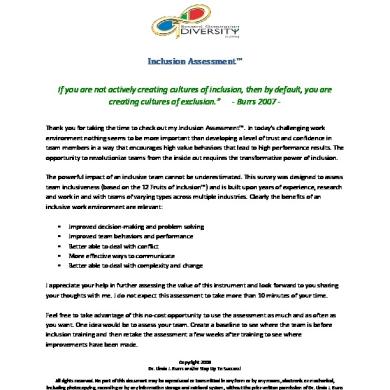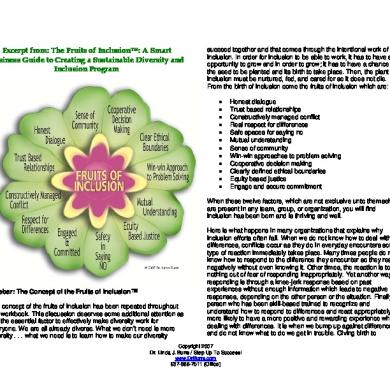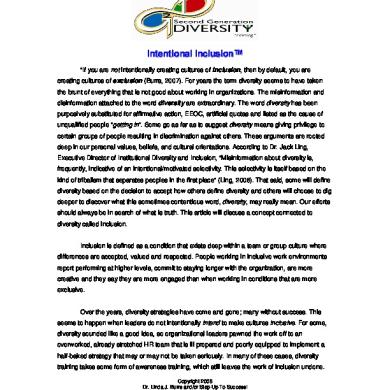Intentional Inclusion™
This document was uploaded by user and they confirmed that they have the permission to share it. If you are author or own the copyright of this book, please report to us by using this DMCA report form. Report DMCA
Overview
Download & View Intentional Inclusion™ as PDF for free.
More details
- Words: 1,457
- Pages: 3
Intentional Inclusion™ “If you are not intentionally creating cultures of inclusion, then by default, you are creating cultures of exclusion (Burrs, 2007). For years the term diversity seems to have taken the brunt of everything that is not good about working in organizations. The misinformation and disinformation attached to the word diversity are extraordinary. The word diversity has been purposively substituted for affirmative action, EEOC, artificial quotas and listed as the cause of unqualified people “getting in”. Some go as far as to suggest diversity means giving privilege to certain groups of people resulting in discrimination against others. These arguments are rooted deep in our personal values, beliefs, and cultural orientations. According to Dr. Jack Ling, Executive Director of Institutional Diversity and Inclusion, “Misinformation about diversity is, frequently, indicative of an intentional/motivated selectivity. This selectivity is itself based on the kind of tribalism that separates peoples in the first place” (Ling, 2008). That said, some will define diversity based on the decision to accept how others define diversity and others will choose to dig deeper to discover what this sometimes contentious word, diversity, may really mean. Our efforts should always be in search of what is truth. This article will discuss a concept connected to diversity called inclusion.
Inclusion is defined as a condition that exists deep within a team or group culture where differences are accepted, valued and respected. People working in inclusive work environments report performing at higher levels, commit to staying longer with the organization, are more creative and they say they are more engaged than when working in conditions that are more exclusive.
Over the years, diversity strategies have come and gone; many without success. This seems to happen when leaders do not intentionally intend to make cultures inclusive. For some, diversity sounded like a good idea, so organizational leaders pawned the work off to an overworked, already stretched HR team that is ill prepared and poorly equipped to implement a half-baked strategy that may or may not be taken seriously. In many of these cases, diversity training takes some form of awareness training, which still leaves the work of inclusion undone. Copyright 2008 Dr. Linda J. Burrs and/or Step Up To Success! All rights reserved. Exception: A reviewer may quote brief passages for a review. Intentional Inclusion™, Fruits of Inclusion™ Graphic and Second Generation Diversity Training™ logo is trademarked ™ to Dr. Linda J. Burrs and Step Up to Success! Miamisburg, OH 45342 Page #1
It is one thing to teach people to be aware of their differences, it is quite another to teach people the skills necessary to live with and deal with each other’s diversities. That said there are four major challenges to creating a culture of intentional inclusion. These four challenges are communication, complexity, conflict and change. These four C’s left unchallenged leave even the best structured and best resourced diversity programs stressed and struggling to reach their desired goals.
These 4 challenges to inclusion, while independent concepts, are congruent; meaning they are interrelated and seem to feed off each other. If an individual has poor interpersonal communication skills, then chances are they will also tend to not deal with conflict appropriately. On the other hand if one is easily hijacked by the complexity of life, then they may also be more likely to dislike change. If change is distasteful, then conflict will be seen in a negative light; nor will one be likely to embrace having to communicate with those they are in conflict. The good news is that these interlocking challenges are more easily dealt with than one might think. The way to “fix” these challenges are through the work of “intentional inclusion™”.
How one communicates, how they deal with complexity and change and certainly how one behaves while in conflict, relates directly to how that individual may deal with differences in any form. Intentional inclusion™ means one deliberately and with calculated purpose uses the appropriate skills to learn what they do not know (even if they think they do). A culture of intentional inclusion is one that is open, flexible, and agreeable to other ways of dealing with organizational and life issues.
Intentionally inclusive individuals tend to think of themselves as emotionally attractive (emotionally intelligent), appealing socially (people want and enjoy being around them), open and agreeable (others know they will at least be heard), and sympathetic and compassionate with others’ world views. If the possibility that another opinion or way of seeing the world is shut out, then the opportunity to grow is reduced to the immediate circle of friends, family, and coworkers who agree with you and your opinions. This limits one’s capacity and ability to be more inclusive of others thus reducing the prospect of solving problems creatively or to add additional data that may be needed later on. What some fail to understand is that by limiting the capacity to collect additional data, even data deemed irrelevant, they may ultimately hinder their own chances of greater innovation, and what organization does not need more creativity and innovation to help solve real problems? Copyright 2008 Dr. Linda J. Burrs and/or Step Up To Success! All rights reserved. Exception: A reviewer may quote brief passages for a review. Intentional Inclusion™, Fruits of Inclusion™ Graphic and Second Generation Diversity Training™ logo is trademarked ™ to Dr. Linda J. Burrs and Step Up to Success! Miamisburg, OH 45342 Page #2
Intentional inclusion™ and innovation work remarkably well together. Think about what it takes to create a culture of innovativeness . . . a safe space to share concepts and ideas . . . the opportunity for seemingly wild ideas to be heard and seriously considered, and a place where everyone knows it is okay to contribute. You need diverse thinking and communication styles, varying levels of experience and technical savvy, fresh eyes and ears and an energized and committed team to create winning solutions without the boundaries of self-inflicted over control. Most important, innovation will thrive in a culture where both written and unwritten policies support diverse approaches to problem solving and the need to engage and support differences. This type of innovative culture is possible with intentional inclusion™.
Ask yourself … how intentional are your efforts at making inclusion work in your organization? When some are included and others excluded, are you fully tapping into the vast potential of your team or group? When you eliminate ideas because they do not come from your team, do you realize you are eliminating a pool of possible solutions? Who do you invite to your brainstorming sessions . . . the leaders of your teams or those who actually work on the front lines and hear what your customers are telling them? Do you brainstorm with those outside your department? Do you see outsiders as opportunities for fresh thoughts or do you exclude them because of territorial or political turfs? Who don’t you invite to participate in dealing with complex issues thus limiting perspective, approaches and solutions to the ideas of those who think and believe as you? At the end of the day, the bottom line to any strategy is . . . you MUST deliver results. Intentional inclusion™ has the potential to create learning opportunities that help the organization move forward. This does not mean there will not be obstacles and setbacks. It does, however, mean the promise for improvements are real when the skills necessary to purposefully deal with differences are learned and applied. About the author: Dr. Linda Burrs is the CEO and Principal Consultant of the Step Up to Success! consulting firm that focuses on Second Generation Diversity Training™ and inclusion strategies. For more than 25 years, Dr. Burrs has brought her rich dynamic approach to the corporate and professional training arena. The breadth of her experience crosses all walks of social and organizational life including law firms, technology organizations, educators, business professionals, leadership groups and non-profit groups. Dr. Burrs is the author of the book: The Fruits of Inclusion™: A Smart Business Guide to Creating a Sustainable Diversity and Inclusion Program. The book is available on www.barnesandnoble.com, www.amazon.com and www.DrBurrs.com. She is also the author of the Second Generation Diversity Training™ program series. For more detailed information on available programs, please visit: www.DrBurrs.com. Dr. Burrs is a sought after public speaker and presenter for her deep expertise and engaging programs. You may contact her at: [email protected] or 937-866-7511. Copyright 2008 Dr. Linda J. Burrs and/or Step Up To Success! All rights reserved. Exception: A reviewer may quote brief passages for a review. Intentional Inclusion™, Fruits of Inclusion™ Graphic and Second Generation Diversity Training™ logo is trademarked ™ to Dr. Linda J. Burrs and Step Up to Success! Miamisburg, OH 45342 Page #3
Inclusion is defined as a condition that exists deep within a team or group culture where differences are accepted, valued and respected. People working in inclusive work environments report performing at higher levels, commit to staying longer with the organization, are more creative and they say they are more engaged than when working in conditions that are more exclusive.
Over the years, diversity strategies have come and gone; many without success. This seems to happen when leaders do not intentionally intend to make cultures inclusive. For some, diversity sounded like a good idea, so organizational leaders pawned the work off to an overworked, already stretched HR team that is ill prepared and poorly equipped to implement a half-baked strategy that may or may not be taken seriously. In many of these cases, diversity training takes some form of awareness training, which still leaves the work of inclusion undone. Copyright 2008 Dr. Linda J. Burrs and/or Step Up To Success! All rights reserved. Exception: A reviewer may quote brief passages for a review. Intentional Inclusion™, Fruits of Inclusion™ Graphic and Second Generation Diversity Training™ logo is trademarked ™ to Dr. Linda J. Burrs and Step Up to Success! Miamisburg, OH 45342 Page #1
It is one thing to teach people to be aware of their differences, it is quite another to teach people the skills necessary to live with and deal with each other’s diversities. That said there are four major challenges to creating a culture of intentional inclusion. These four challenges are communication, complexity, conflict and change. These four C’s left unchallenged leave even the best structured and best resourced diversity programs stressed and struggling to reach their desired goals.
These 4 challenges to inclusion, while independent concepts, are congruent; meaning they are interrelated and seem to feed off each other. If an individual has poor interpersonal communication skills, then chances are they will also tend to not deal with conflict appropriately. On the other hand if one is easily hijacked by the complexity of life, then they may also be more likely to dislike change. If change is distasteful, then conflict will be seen in a negative light; nor will one be likely to embrace having to communicate with those they are in conflict. The good news is that these interlocking challenges are more easily dealt with than one might think. The way to “fix” these challenges are through the work of “intentional inclusion™”.
How one communicates, how they deal with complexity and change and certainly how one behaves while in conflict, relates directly to how that individual may deal with differences in any form. Intentional inclusion™ means one deliberately and with calculated purpose uses the appropriate skills to learn what they do not know (even if they think they do). A culture of intentional inclusion is one that is open, flexible, and agreeable to other ways of dealing with organizational and life issues.
Intentionally inclusive individuals tend to think of themselves as emotionally attractive (emotionally intelligent), appealing socially (people want and enjoy being around them), open and agreeable (others know they will at least be heard), and sympathetic and compassionate with others’ world views. If the possibility that another opinion or way of seeing the world is shut out, then the opportunity to grow is reduced to the immediate circle of friends, family, and coworkers who agree with you and your opinions. This limits one’s capacity and ability to be more inclusive of others thus reducing the prospect of solving problems creatively or to add additional data that may be needed later on. What some fail to understand is that by limiting the capacity to collect additional data, even data deemed irrelevant, they may ultimately hinder their own chances of greater innovation, and what organization does not need more creativity and innovation to help solve real problems? Copyright 2008 Dr. Linda J. Burrs and/or Step Up To Success! All rights reserved. Exception: A reviewer may quote brief passages for a review. Intentional Inclusion™, Fruits of Inclusion™ Graphic and Second Generation Diversity Training™ logo is trademarked ™ to Dr. Linda J. Burrs and Step Up to Success! Miamisburg, OH 45342 Page #2
Intentional inclusion™ and innovation work remarkably well together. Think about what it takes to create a culture of innovativeness . . . a safe space to share concepts and ideas . . . the opportunity for seemingly wild ideas to be heard and seriously considered, and a place where everyone knows it is okay to contribute. You need diverse thinking and communication styles, varying levels of experience and technical savvy, fresh eyes and ears and an energized and committed team to create winning solutions without the boundaries of self-inflicted over control. Most important, innovation will thrive in a culture where both written and unwritten policies support diverse approaches to problem solving and the need to engage and support differences. This type of innovative culture is possible with intentional inclusion™.
Ask yourself … how intentional are your efforts at making inclusion work in your organization? When some are included and others excluded, are you fully tapping into the vast potential of your team or group? When you eliminate ideas because they do not come from your team, do you realize you are eliminating a pool of possible solutions? Who do you invite to your brainstorming sessions . . . the leaders of your teams or those who actually work on the front lines and hear what your customers are telling them? Do you brainstorm with those outside your department? Do you see outsiders as opportunities for fresh thoughts or do you exclude them because of territorial or political turfs? Who don’t you invite to participate in dealing with complex issues thus limiting perspective, approaches and solutions to the ideas of those who think and believe as you? At the end of the day, the bottom line to any strategy is . . . you MUST deliver results. Intentional inclusion™ has the potential to create learning opportunities that help the organization move forward. This does not mean there will not be obstacles and setbacks. It does, however, mean the promise for improvements are real when the skills necessary to purposefully deal with differences are learned and applied. About the author: Dr. Linda Burrs is the CEO and Principal Consultant of the Step Up to Success! consulting firm that focuses on Second Generation Diversity Training™ and inclusion strategies. For more than 25 years, Dr. Burrs has brought her rich dynamic approach to the corporate and professional training arena. The breadth of her experience crosses all walks of social and organizational life including law firms, technology organizations, educators, business professionals, leadership groups and non-profit groups. Dr. Burrs is the author of the book: The Fruits of Inclusion™: A Smart Business Guide to Creating a Sustainable Diversity and Inclusion Program. The book is available on www.barnesandnoble.com, www.amazon.com and www.DrBurrs.com. She is also the author of the Second Generation Diversity Training™ program series. For more detailed information on available programs, please visit: www.DrBurrs.com. Dr. Burrs is a sought after public speaker and presenter for her deep expertise and engaging programs. You may contact her at: [email protected] or 937-866-7511. Copyright 2008 Dr. Linda J. Burrs and/or Step Up To Success! All rights reserved. Exception: A reviewer may quote brief passages for a review. Intentional Inclusion™, Fruits of Inclusion™ Graphic and Second Generation Diversity Training™ logo is trademarked ™ to Dr. Linda J. Burrs and Step Up to Success! Miamisburg, OH 45342 Page #3
Related Documents

Inclusion
May 2020 29
Inclusion
June 2020 24
Intentional Spinner
November 2019 36
Yarnell Inclusion
June 2020 12
Financial Inclusion
November 2019 25
Diversity Inclusion
December 2019 24More Documents from "Marco Ramirez"

Diversity - More Than A Notion
May 2020 20
Brain Rats
May 2020 9
Inclusion Assessment
May 2020 15

